 |
Somerset &
Dorset Joint Railway Signalling at Masbury |
 |
||||||||
|
||||||||||
The station and signal-box at Masbury were situated on the main line of the Somerset & Dorset Joint Railway (S&DJR), on the section from Bath Junction to Evercreech Junction in the county of Somerset which was known historically as the 'Bath Extension'. The Somerset and Dorset Railway (S&DR) opened its 'Bath Extension' from Evercreech Junction to Bath in 1874 and a station was provided at Masbury. At first the line was single-track throughout with just a few passing-places, but the line through Masbury was doubled in 1892. [Click here to read more about early S&DR/S&DJR Signalling and the Bath Extension]. The S&DR became the S&DJR in 1875 when the line was leased jointly by the Midland Railway (MR) and London & South Western Railway (L&SWR).
After the Grouping of the railways of Great Britain in 1923 the S&DJR became a Joint line under the control of the London, Midland & Scottish Railway (LMS) and the Southern Railway (SR), who were the successors to the MR and L&SWR respectively. When the railways were nationalised in 1948 the Joint line came under the control of British Railways (Southern Region) (BR(SR)), but in due course control of the old Bath Extension section passed to British Railways (Western Region) (BR(WR)) until the line closed on 6-March-1966.
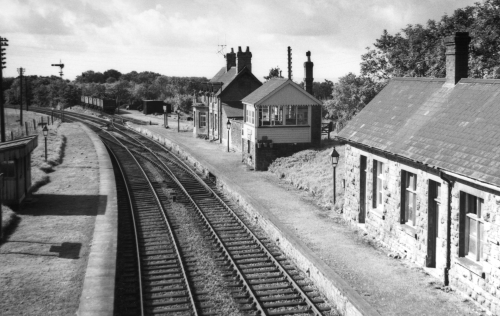
Masbury station looking south on 11th June 1961
Note: the alternative spellings 'Masbury' and 'Maesbury' have been used for different features in the area, but the station was always known as 'Masbury' by the S&DJR and that spelling is used in RailWest. 'Maesbury Castle' was a nearby Iron Age hill-fort.
When Masbury station was opened on 20-July-1874 it was on a section of single line between Binegar and Shepton Mallet, so initially only a single platform was provided on the Up side of the line. In the 1886 Ordnance Survey 1:2500 map a solitary building is shown near the south end of the platform. In later years there was a single-storey station building of stone construction near the north end of the platform, which contained just a booking office and waiting room, whilst further south on the platform was a stone-built two-storey house for the station-master, both of which appear on the 1903 OS map. One source states that the house was built of Doulting stone in 1894, so it may be the case that the station facilities were improved when the line was doubled in 1892; on the other hand, from a contemporary 1874 report of the opening of the line it seems probable that both those buildings were original features. At the north end of the station the railway passed under Bridge 70 and a short distance further north towards Bath the line passed over Masbury Summit, the highest point on the S&DJR at 811 feet above sea level.
In 1877 a siding was provided on the Up side of the line at the south end of the station to serve a small goods yard, although no goods shed was ever built at Masbury. When the line was doubled between Binegar and Shepton Mallet in 1892 a second platform was added on the Down side, although the only passenger facility ever provided on it was a small wooden shelter. The new platform was 350' long, the original (now Up) platform being 300' in length. A short siding was provided at the south end of the new platform, although it was so short that its purpose is unclear - was it perhaps simply to hold a bank engine or a few wagons removed from a Down train?
Increased siding facilities were provided on the Down side in 1928 to serve a stone-crushing plant for Mendipadam (a subsidiary of the Emborough Stone Company) and a new exit from those sidings was provided further down the line. Those sidings were utilised in 1942 to serve a World War II US military fuel storage depot, and it is possible that additional sidings were added, but this can not be confirmed because of the lack of suitable map information for that period. Masbury station was sited at a fairly remote location high on the Mendip Hills and it could be a very bleak and lonely spot at the best of times. Passenger usage was never very great and on 20-September-1938 the station was reduced to the status of an unstaffed Halt and it remained as such until it closed with the line on 6-March-1966.
When the Bath Extension was opened in 1874 the line was single-track throughout, with just a few passing-places, and Masbury was merely an intermediate station in the single-line section between Binegar and Shepton Mallet. However it known that elsewhere on the S&DJR (such as at Midford) it was the practice at such stations to provide a few signals (probably just a Distant and Home in each direction) worked from a small lever-frame, probably located in a small wooden hut on the platform. The block working on the single-line was by block telegraph without any train staff and only the passing-loops should have been block posts, but it is clear from the evidence in the Board of Trade (BoT) Report on the accident at Foxcote (near Radstock) in August 1876 that Midford had been acting as some form of intermediate block post at that time. Minute 368 of the S&DJR Officers' Meeting on 8-November-1876 records a decision to enlarge the signal-box and dispense with the interlocking of the signals at Masbury, so it is clear therefore that there was already some form of signalling at Masbury by that date.
The steep gradients on the approaches to Masbury Summit meant that it was often necessary to bank Down goods train all the way from Radstock and Up goods trains from Evercreech Junction. In the early days of the Bath Extension the bank engine on a Down train would collect a special 'Bank Engine Staff' from the signalman at Binegar as the train passed that station. Once the train had passed over the summit then the main part of the train would continue on to Masbury (and thence to Shepton Mallet etc), while the bank engine would return to Binegar under authority of the staff (and then back to Radstock). In the Up direction however a bank engine would run coupled to the train all the way to Binegar before returning to Evercreech Junction.
In 1877 a siding was provided on the Up side of the line at the south end of the station to serve a small goods yard and this was connected to the main line by a crossover facing to Down trains. According to details in National Archives file MT6/192/5 signals were provided for both directions, controlled by an 8-lever frame located on the platform, although it is unclear whether the lever-frame was covered. Although Distant, Home and Starting signals were provided in the Down direction, in the Up direction only a Distant and Home were provided and curiously the latter was not in a suitable position to protect the siding connection. At the BoT's request a new Up Home signal was added at a suitable location (the previous Up Home becoming the Up Starting), so it must be assumed that the lever-frame was extended to (at least) 9 levers. The BoT recorded that the Up and Down signals were not interlocked with each other, so that all signals could be cleared when the station was closed at night.
Although the block-post status of the revised arrangements at Masbury is not specified, it is clear from various details in the S&DJR Working Timetable (WTT) Appendix No 7 dated 1-March-1886 that at that time the SB was worked as a block-post and its opening hours were listed as 7:45am until arrival of last passenger train at next post in advance, weekdays only. The same Appendix contained instructions stipulating that wagons for Masbury siding had to be worked from Binegar on a banked Down goods train, the wagons destined for Masbury being attached behind the bank engine with a brake-van at their rear. Once the main part of the Down train had passed over Masbury Summit and proceeded on towards Shepton Mallet, then the bank engine had to proceed slowly towards Masbury with those wagons in tow. On arrival at Masbury the bank engine would be uncoupled and run past the siding, after which the wagons would be gravitated into the siding. The bank engine then would collect any outgoing wagons, plus the brake-van, and return with them to Binegar. It is presumed those were the only circumstances at that time when a Down bank engine actually passed over Masbury summit and went as far as the station.
On 10-October-1886 Electric Train Tablet (ETT) working was introduced on the single-line section between Binegar and Shepton Mallet (using Tyers No 1 instruments) in place of the block telegraph. Although Masbury would have ceased to be a block-post thereafter, it is clear that the signals were retained for 'request stop' purposes, as S&DJR WTT Appendix No 9 of 1-February-1889 states that (in common with Midford and Spetisbury):-
"The normal position of the Signals ... must be at the "Off" position, except when required to be used to stop a Train which is marked to call by Signal only, or to protect any impediment or obstruction which may be on the Line, in accordance with Rule 157 of the Committee's Book of Rules and Regulations. In accordance with this Rule, when a Train has stopped at the Station, the Signals in both directions must be placed at "Danger", and remain so until the Train has again started, and has passed out of sight."
It is not clear whether the levers controlling access to the siding were locked/unlocked now by a tablet for the single-line section, or still relied purely on the protection given by the interlocking with the signals. The opening hours remained as 7:45am until last passenger train, weekdays only, although as those times were listed in a table for 'telegraph stations and signal posts' it is unclear whether the times related to the opening/closing of the signal-box itself or simply the telegraph facilities available at Masbury.
In 1892 the line from Binegar to Shepton Mallet was doubled and that work included the provision of a new signal-box (SB) at Masbury (and also a new SB at nearby Winsor Hill). This SB contained a lever-frame of the Stevens pattern with levers at 4.1/8" centres; there were 20 levers, of which 14 were working and 6 were spares. Three of the working levers were push-pull levers, which stood normally in a mid-way position; pulling a lever back worked one signal, pushing the lever forward worked a different signal. The new SB became a block-post for the new double-track sections to Binegar and Winsor Hill, when the block working reverted to Absolute Block and is presumed to have used the S&DJR standard 'block telegraph' instruments.
The doubling work was inspected for the BoT by Major Marindin on 15-November-1892 (National Archives file MT6/614/2) and his Report stated that actual double-line working was not in use at that time as the new connections had not been made yet at Binegar and Shepton Mallet. A later file entry dated 30-January-1893 states that "due to hard weather" at least another two weeks would be required and a further inspection was not made until 14-March-1893, by which time double-line working was in operation. The late CR Clinker recorded that the double-track was brought into use on 20-November-1892 according to S&DJR Signal Instruction No 56, but no copy of that Instruction has been sighted yet for confirmation. It is unclear if the new SB was opened on the same date, as Clinker also recorded that the new SB at Winsor Hill was opened on the following day (21st November).
The new SB was located on the Up platform between the station building and the station-master's house, and was constructed generally to the contemporary S&DJR TYPE 2 style with a gabled-ended timber superstructure on a stone base. However all known photographs of the SB do show some detail differences from other S&DJR TYPE 2 SBs, including:-
but as those photographs date from about the 1920s onwards it is not known if any differences were original features or the result of subsequent alterations. Sadly it not possible to draw any conclusion by comparison with the new SB built at Winsor Hill at the same time, as that was of a unique all-stone design. However, as the new SBs built at Midford in 1892 and Wellow in 1894 both had the traditional S&DJR TYPE 2 design features, then it may be a valid assumption that the differences at Masbury were not the result of a simplification of the design at that time.
Use of the Bank Engine Staff at Binegar ceased after the line had been doubled through Masbury; instead the bank engine on a Down Train would continue with the train as far as Masbury station, where it would drop off its train and use the crossover (points 9) to return to Binegar on the Up line. Bank engines on Up trains continued to run all the way to Binegar, before crossing over there to return to Evercreech Junction on the Down line. By the time of the 1905 edition of the S&DJR WTT Appendix the SB was listed as opening at 8:30pm on Sunday evenings and then remaining open throughout the week until after the passing of the last train on the following Sunday morning.
One item not marked on the signal diagram was a spring-loaded trailing catch-point located on the Up line between the Up Distant and Up Home signals. This catch-point would have been provided to guard against any runaways, whether from un-banked Up goods trains or shunting operations at Masbury, running 'wrong direction' back along the Up line on the steep gradient down towards Winsor Hill. It is not known if it was installed in 1892, but certainly it was listed in the 1905 S&DJR WTT Appendix which stated that "the position is indicated by the word 'Switch' painted in black letters on the small Signal-box covering the handle of the Catch Points". (That 'signal-box' would have been little more than a small hut.) The precise original location of the catch-point is unknown, but by the time of the 1933 edition of the WTT Appendix it had been moved further out to be 520 yards in rear of the Up Home in order to provide clearance for the longer goods trains that became possible after the introduction of the 2-8-0 '7F' engines (see Minute 7786 of the S&D Officers' Conference on 23-April-1926). At some unknown date the 'box' was removed and replaced by a small 'CATCH POINTS' notice on a post close to the catch-point lever.
One feature of the early signalling at many S&DJR double-line locations was the provision of a subsidiary 'Shunt By' arm under the stop signal next in rear of the section signal, and signal 5 at Masbury was an example of that practice. In common with other S&DJR subsidiary arms this signal would have been a full-size arm with a ring, but no photograph of it is known as it was abolished on 9-December-1912 (S&DJR Signal Instruction 234), after which lever 5 became a spare. In the same year, and possibly at about the same time, the arrangements for working the six ground signals were altered although the reason for the work is unknown. The three push-pull levers were altered to work as ordinary levers for three of the ground signals, the other three signals being connected to three of the original spare levers. The revised arrangement for 1913 onwards is shown in the diagram below.
During the 1920s the night shift at Masbury signal-box was abolished as an economy measure, so to avoid the need for banking engines on Down trains to go all the way to Shepton Mallet (as the intervening box at Winsor Hill also closed at night) the use of a Bank Engine Staff was re-introduced at Binegar with effect from 10-October-1927 (click here for further information). Although this change did not affect the actual method of block working at Masbury, the S&DJR block telegraph instrument for the section to Binegar was replaced by a SR standard 3-wire 3-position instrument in order to provide the necessary block controls (the S&DJR instrument working to Winsor Hill was not changed).
In 1928 work was carried out at Masbury to provide new private siding facilities for Mendipadam Ltd adjacent to the Down line. The trap-point at the exit from the Down Siding now lead to a new siding which ran parallel to the Down line for some distance towards Winsor Hill, before connecting back into the Down line by a new trailing point about 332 yards from the signal-box. A second siding branched off the Down siding near to its buffer-stop, passed under a new stone loading hopper, and connected into the other new siding close to its exit at the south end.
In connection with this work two signal alterations took place on 23-September-1928 (S&DJR Signal Instruction 287). The Down Starting signal (3) was replaced by a new signal 30' high and located 4 yards nearer to the station, whilst the Down Advanced Starting signal (4) was replaced by a new signal 30' high placed on the Up side of the line 260 yards further away from the signal-box. Subsequently the new siding was brought into use on 6-November-1928 (S&DJR Signal Instruction 289). A new ground-frame (GF) was installed to work the new trailing connection from the Down line and this was released by lever 5 in the signal-box. Ground signal 10 was moved 10 yards nearer the signal-box and fitted with a yellow miniature semaphore arm (click here for more details on S&DJR 'yellow' ground signals). A new track-circuit 'A' was installed on the Down line, extending from ground signal 12 to a position just beyond signal 4, and occupation of that track-circuit locked lever 3 (the Down Starting). The revised arrangement for 1930 onwards is shown in the diagram below.
The new work was inspected for the Ministry of Transport (MoT) on 8-May-1929 by Colonel Trench and his Report dated 15-May-1929 can be read here. The S&DJR wiring diagram for the GF control circuit and track-circuit 'A' can be seen here (although it shows signal 4 on the Down side of the line). That diagram, and other S&DJR records, show that lever 2 in the GF worked the new trailing points and trap-point, and was released by lever 1, which in turn was released electrically by lever 5 in the SB. (Note: the usual SR practice in such installations was for lever 1 to be the release and lever 2 to work the points, and unfortunately some publications erroneously list Masbury as having that arrangement.) The MoT report stated that the reversal of lever 5 (the GF release) locked the commutator of the block instrument for the section to Binegar, thereby preventing the signalman at Masbury from accepting a Down train from Binegar while the GF was in use. (This would be logical, as any train stood between signals 3 and 4 to shunt at the GF would be fouling the 'clearing point' for acceptance.) However there is no indication of that arrangement on the wiring diagram, nor does it appear in a later electrical locking table.
[Note: although Signal Instruction 289 was quite specific that the GF was controlled electrically and that fact is confirmed by various associated diagrams, it should be noted that curiously the 1933 WTT Appendix recorded it as being bolt-locked from the SB (ie mechanically released). It is assumed that the WTT Appendix was incorrect.]
Ironically the Mendipadam company existed for less than a year before it went into voluntary liquidation, after which it is believed to have been acquired by the Emborough Stone Company (which in turn became part of Roads Reconstruction Ltd). Although the new rail facilities were located on the east side of the line at Masbury, the actual quarry was some distance away to the west and it is unclear how they proposed to transport their stone from quarry to railway. It is possible that it was something of a speculative venture which may not have seen much real use, and this may account for the fact that the private siding facilities appear to be lightly used by the time of World War II.
During WWII a US Army fuel dump was established on land to the east of the station and in 1942 the War Office requisitioned the former Mendipadam siding. The S&D Joint Committee Minutes No 5146 dated 4-February-1942 records that:-
"It was reported by Joint Conference minute No.1027 that land and a siding at Masbury belonging to Roads Reconstruction Ltd., which siding was the subject of an agreement with Mendipadam Ltd., the predecessors of the former firm, has been requisitioned by the War Office for the purpose of a petrol dump. Before the siding could be used it would be necessary to carry out certain reconditioning work at an estimated cost of £223, to be borne by the War Office, who would enter into an agreement covering the arrangement."
It is a matter of conjecture whether the need to do 'reconditioning work' might imply that the siding had fallen into disrepair due to lack of use. It may be simply the case that it was considered necessary and/or prudent to have a better standard of trackwork for shunting wagons loaded with inflammable fuel rather than inert stone. Minute 1027 had stated that "The traffic will arrive by train and be redistributed by road", but it is unclear whether 'redistributed' meant from the existing stone siding into the new military camp, or from that camp to other military locations. There is some circumstantial evidence that additional sidings were laid from the stone siding into the camp, but in the absence of any relevant map records the number and layout of any such sidings can not be confirmed. Certainly the camp site was cleared after the war along with any additional sidings, but it is unclear whether the original sidings were re-used subsequently for stone traffic.
The photograph below shows a Down train in BR days passing the southern exit from the former Mendipadam sidings, with the protecting trap-point and gate at the private owners' boundary. It will be noted that the single-blade trap-point mentioned in the MoT report has been replaced by a full two-blade trap-point, possibly as part of the war-time 'reconditioning work'. In the foreground (see enlargement view) can be seen the 2-lever GF of the 'knee' type commonly used by the SR for such installations.
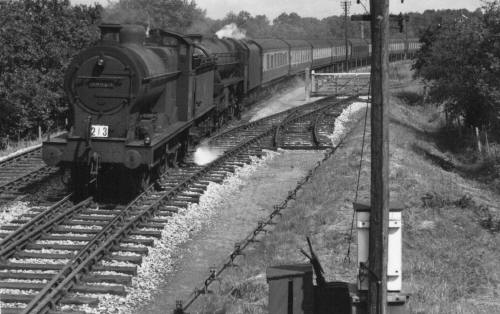 |
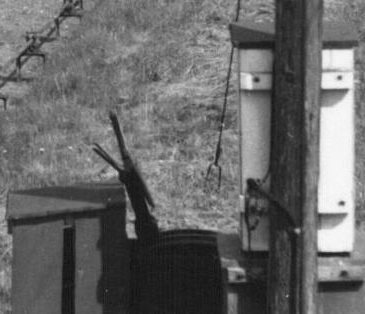 |
|
| The south exit from Masbury Down Sidings in the 1950s Click picture for larger image |
Masbury Ground-Frame |
In the absence of any suitable photographic record it is not possible to be definitive about the signals provided at Masbury in 1892. However it is likely that the main running signals were lower-quadrant (LQ) arms on wooden posts, and the ground signals were of the Stevens 'flap' type, similar to contemporary installations at Binegar and Midford. (Click here for more details on S&DJR signals.) By the 1930s most, if not all, of the main running signals had been altered. A 1937 photograph shows that most ground signals were still of the 'flap' type, except for signal 10 which had been changed as a result of the 1928 alterations; all except signal 10 had been changed to the 'half-disc' pattern by the 1950s.
The Down Starting (3) and Down Advanced Starting (4) signals were replaced as part of the 1928 alterations by LQ arms on lattice posts. On 11-August-1931 the Down Distant signal (1) was replaced by a new signal 20' high and 192 yards further north than its predecessor. In its new position it was 1000 yards from the Down Home (2) and this relocation may have been a reflection of a need to improve braking distances, perhaps as a result of increased train speeds. Two days later on 13-August-1931 the Down Home signal (2) was replaced by a new signal close to it, which had LQ arms on a lattice post. Both those alterations were reported in S&DJR Signal Instruction 315, which states that the new Down Home had co-acting arms, the upper arm being at 35' high and the lower arm at 20' high. (It is not known if the previous Down Home also had co-acting arms.) The previous Down Distant had been located immediately to the north of over-bridge 69, which became a popular location for taking photographs of Down trains approaching Masbury summit; as a result the rear of the new signal (which had a LQ arm) appears in the background of many such photographs, but it has not been possible yet to determine the type of post.
There is a reference in SR records to the provision of a 'new signal' at Masbury on 10-December-1939, but the identity of that signal was not specified. There is no evidence that any additional signal was added to the layout at that time, so it is probable that the reference was simply to the replacement of an existing signal by a new post and arm. It is possible that the signal was the Up Distant (20), as it is known that signal had a SR-type rail-built post and upper-quadrant (UQ) arm in BR days, but no other specific reference to its renewal is known. SR records also confirm that the Up Starting (18) was renewed on 5-July-1942 and in BR days it had a lattice post with UQ arm. The Up Home (19) still had a LQ arm in early BR days and it is believed to have been still on a wooden post at that time, but on 29-June-1952 (according to S&D Weekly Notices) it was replaced by a SR-type rail-built post with an UQ arm at 28' above rail level and sited a little closer to the Up Siding. It is clear from photographic coverage that at some time between August 1960 and early 1961 the Down Distant signal (1) was replaced again in roughly the same location by a BR(WR) LQ arm on a tubular post; sadly no formal notice of that change has come to light, so the precise date of the work is unknown.
 It is believed that the signalling installation at Masbury remained
essentially unchanged after the 1928 layout alterations, except for the
occasional signal renewal (as described above).
By this time the lever for the catch-point in the Up line was no longer covered
and there was just a simple 'CATCH POINTS' notice on a post adjacent to it
(see photo on the right). A copy of the BR(SR) signal diagram for 1949 can be
seen here,
whilst the 'dog-chart' available
here depicts the physical layout of the actual mechanical locking. (Although that
chart dates from the SR period, it is believed to be valid for the 1949 layout.)
The first major change came in 1959 when both connections into the Down Sidings and the GF were taken out-of-use on
15-March-1959, after which track-circuit 'A' was extended back to signal 3 (BR(SR) Weekly Notice P/EW11); subsequently
both track-circuit 'A' and signal 4 were abolished on 24-September-1959 (BR(SR) Weekly Notice P/EW35).
It is believed that the signalling installation at Masbury remained
essentially unchanged after the 1928 layout alterations, except for the
occasional signal renewal (as described above).
By this time the lever for the catch-point in the Up line was no longer covered
and there was just a simple 'CATCH POINTS' notice on a post adjacent to it
(see photo on the right). A copy of the BR(SR) signal diagram for 1949 can be
seen here,
whilst the 'dog-chart' available
here depicts the physical layout of the actual mechanical locking. (Although that
chart dates from the SR period, it is believed to be valid for the 1949 layout.)
The first major change came in 1959 when both connections into the Down Sidings and the GF were taken out-of-use on
15-March-1959, after which track-circuit 'A' was extended back to signal 3 (BR(SR) Weekly Notice P/EW11); subsequently
both track-circuit 'A' and signal 4 were abolished on 24-September-1959 (BR(SR) Weekly Notice P/EW35).
In October 1963 BR(WR) Notice K2/37/63 reported that the Up Siding connection and disc "have been recovered", but as that was the fourth notification of that alteration then in fact the connection may have been taken out-of-use about June that year. (There is an unconfirmed report that it was taken out-of-use on 10-June-1963 and the siding removed later that month. In a photograph taken on 5-May-1964 a part of trailing point 13 appears to have been dismantled, but the rest of that connection and the Up siding still remained in place, albeit disused.) In the absence of any information to the contrary then it is assumed that the crossover (points 9) and its associated shunt signals (14 and 15) remained in use, as they were still in place in a photograph taken on 5-May-1964.
Masbury signal-box was closed on 1-July-1964 and all its remaining signals were abolished; photographic evidence shows that the crossover had been removed by mid-1965. The station itself became simply an unstaffed intermediate halt in a block section from Binegar to Shepton Mallet until it was closed with the rest of the line on 6-March-1966.
Postscript...
The signal-box and the small waiting shelter on the Down platform were demolished some time after closure and it is reported that the track had been cleared from the site by mid-May 1968; however both platforms, the station building and the station-master's house (now extended) survive in private ownership. The site has changed hands on a number of occasions since the railway closed, but at the time of writing (2019) it is in the hands of new owners who are refurbishing both buildings and re-building the structure of the signal-box. Various other 'relics' of the former railway survive around the site, such as the 'kissing-gate' at the top of the steps leading from the overbridge to the former Up platform. The cutting north of Bridge 70 towards the summit is overgrown and a geological Site of Special Scientific Interest.
| Buildings at Masbury station in 2018 | ||||
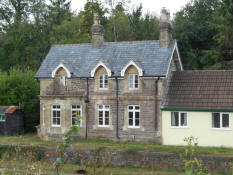 |
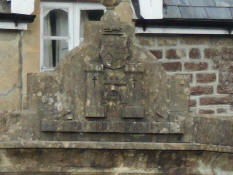 |
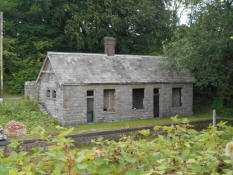 |
||
| Stationmaster's house | Crest on SM's house | Station building | ||
| Click pictures for larger images | ||||
© CJL Osment 2015-23
Thanks to Steve Ehrlicher and Peter Kay for material from the National Archives, to John Creed for details from
Signalling Record
Society archives, to Mike Arlett for additional archive
material, also Peter Russell. Masbury station 1961 photograph John Eyers collection
South Western Circle,
Masbury siding + GF photographs courtesy Keith Barrett collection, other images WCRA collection.
References